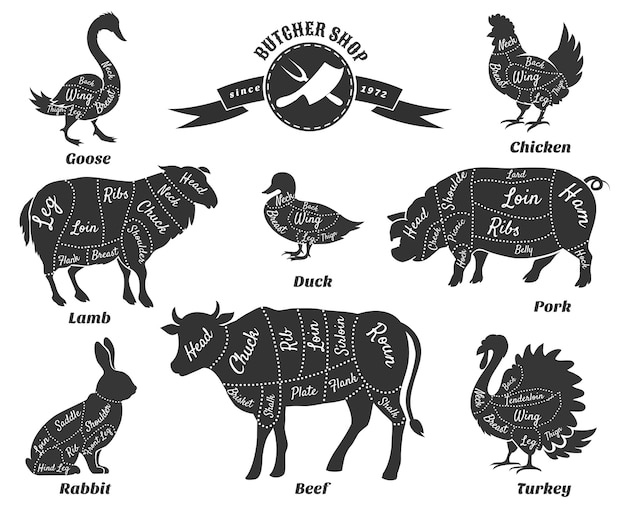{This website may include affiliate links and advertising to provide you with recipes. Check out my disclosure policy. Ready to master the art of cooking meat? Let’s break down the different cuts of meat to help you feel confident in creating delicious dishes. Whether you’re a fan of tender London broil, succulent pork roast, or crispy chicken drumsticks, we’ve got you covered!
Understanding the basics of meat cuts not only saves you money by making budget-friendly choices and taking advantage of sales, but it also maximizes flavor in your meals. By knowing which cuts to use and how to cook them, you can approach recipes with confidence, mastering various cooking techniques and flavors.
Why is it crucial to know the different cuts of meat? Well, it’s like having a secret weapon in the kitchen that elevates your cooking game and guides your shopping decisions. Each cut has its unique cooking requirements, flavor profiles, and should be selected carefully to shine in your dishes. With this knowledge, you’ll feel like a culinary expert, whipping up impressive meals every time while also saving money and shopping like a pro without compromising taste.
Let’s start with beef! Here’s a breakdown of the main cuts and where they come from:
- Chuck: Tough and fatty, perfect for ground beef and slow-cooked dishes like pot roast from the shoulder area.
- Rib: Tender, juicy cuts ideal for grilling or roasting, found in ribs 6-12, excluding the first five.
- Loin: Split into short loin and sirloin, offering leaner cuts like T-bone and Porterhouse in the short loin, and flavorful but slightly tougher cuts in the sirloin.
- Round: Lean and tough cuts from the hind legs, great for roasting or braising after marinating for added flavor and tenderness.
- Flank: Lean flank steak perfect for grilling, marinate and slice thinly for stir-fries or tacos.
- Plate (Short Plate): Flavorful cuts from the belly, ideal for braising to keep them moist and tender.
- Brisket: Tough cut from the chest, best for slow cooking methods like smoking or braising for incredible tenderness and flavor.
- Shank: Very lean and tough cuts from the legs above the knee, perfect for stews and braising, creating rich and comforting dishes.
Now, let’s talk about beef grades to know the quality you’re buying:
- Prime-Grade: The highest quality with abundant marbling, tender, and full of flavor.
- Choice-Grade: High-quality beef with less marbling than prime, commonly used for filets.
- Select-Grade: The lowest quality, tougher and leaner with less marbling and flavor.
Moving on to chicken, here are the main cuts to be familiar with:
- Breast: Lean white meat from the chest, versatile and available bone-in, boneless, or thinly sliced.
- Thighs: Rich, fatty dark meat with more flavor than the breast, bone-in and skin-on or boneless and skinless options available.
- Drumstick (Leg): Dark flavorful meat perfect for frying or baking, great for rubs and marinades.
- Wings: Affordable and easy to cook, made up of drumette, wingette, and wing tip, ideal finger food.
Let’s not forget about pork! Here’s a breakdown of the main cuts:
- Leg: Includes the hind leg and rump, best cooked low and slow for a flavorful result.
- Loin: Tender cuts like tenderloin, chops, and baby back ribs, perfect for roasting, searing, or grilling.
- Shoulder: High in fat and tough cuts from the neck, shoulder blade, and upper front legs, great for braising or smoking.
- Belly: Known for being very fatty, ideal for cuts like bacon, pork belly, and spare ribs when rendered down.
Why marinate your meat? Marinating enhances flavor, adds moisture for juiciness, and tenderizes the meat. It’s a great way to elevate cheaper cuts like skirt steak for added flavor and tenderness.
Is bone-in better than boneless? Absolutely! Bone-in cuts keep the meat tender and juicy, add flavor, are often cheaper, help maintain shape while cooking, and result in more flavorful and tender dishes in the end.
Looking to save money when buying meat? Understanding different cuts helps plan meals based on sales. For beef, consider more affordable options like flat iron steak instead of ribeye, or sirloin instead of prime rib. Opt for chicken thighs over breasts for budget-friendly meals, and break down whole chickens at home for cost-effective cuts. When pork roasts are expensive, go for pork roasts instead and consider slicing a whole pork loin into chops at home.
Remember to cook your meat at safe internal temperatures: 165°F for chicken, 140-160°F for beef, and 145°F for pork. And if you’re

